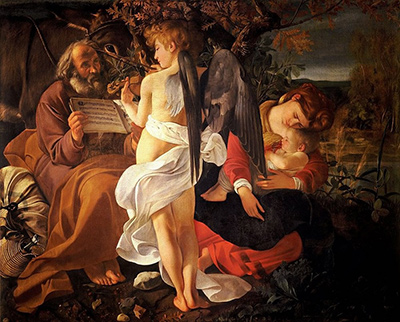Rest on the Flight into Egypt is an artwork painted by the Italian artist Caravaggio.
He made his fortunes by taking on religious contracts and in fact his patrons were often from the church.
This particular point is seen in the artwork Rest on the Flight into Egypt.
Although the artwork isn’t based on any particular event in the Bible, the scene is based on folklore that had been passed around in the early Middle Ages.
As the story goes, the holy family was escaping to Egypt seeking refuge, after receiving word that the child was in danger of being killed by Herod the Great.
While temporarily pausing from their escape, the child commanded the tree to bend to allow Joseph to pick its fruits, and then commanded water to spring out from its roots so that both Mary and Joseph could quench their thirst.
Caravaggio depicts Mary to the right of the painting, holding the child of Christ. In the centre of the painting is an angel, who appears to be playing a hymn.
To the left of the painting is Joseph, who is holding a manuscript. It is said that the angel was an addition made to the story by Caravaggio himself.
Although Caravaggio lived a tumultuous and violent life that one might not associate with religion, he had produced some of the most influential Christian art pieces in his era.
The artwork was created circa 1597, and it is an oil painting done on canvas. The painting is now kept at the Doria Pamphilj Gallery in Rome.
Born as Michelangelo Merisi di Caravaggio in Milan, he lived from 1571 to 1610 and was active during a turning point in the history of art. He became known for his ability to express realism in his paintings as well as draw from nature, instead of relying on past artworks for inspiration.




